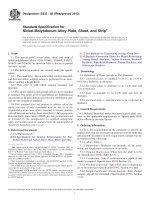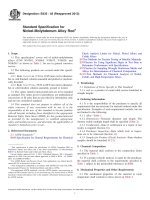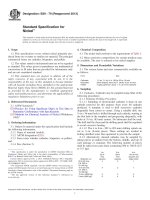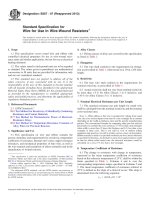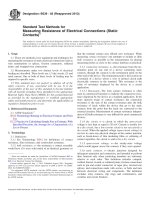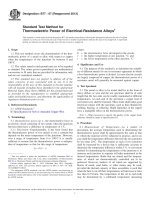Astm b 84 07 (2013)
Bạn đang xem bản rút gọn của tài liệu. Xem và tải ngay bản đầy đủ của tài liệu tại đây (93.85 KB, 5 trang )
Designation: B84 − 07 (Reapproved 2013)
Standard Test Method for
Temperature-Resistance Constants of Alloy Wires for
Precision Resistors1
This standard is issued under the fixed designation B84; the number immediately following the designation indicates the year of original
adoption or, in the case of revision, the year of last revision. A number in parentheses indicates the year of last reapproval. A superscript
epsilon (´) indicates an editorial change since the last revision or reapproval.
1. Scope
4. Baths
1.1 This test method covers determination of the change of
resistance with temperature of alloy wires used for resistance
standards and precision resistors for electrical apparatus.
4.1 Baths for use from −65 to +15°C may consist of toluol,
or equivalent.
4.2 Baths for use above 15 to 250°C may consist of
chemically neutral oils with a low viscosity, having a flash
point at least 50°C higher than the temperature of use.
1.2 The values stated in SI units are to be regarded as
standard. No other units of measurement are included in this
standard.
4.3 The liquid in these baths shall be of such quantity and so
well stirred that the temperature in the region occupied by the
specimen and the thermometer will be uniform within 0.5°C
for any temperature between −65 and +100°C, and within
1.0°C for any temperature above 100 to 250°C. If the temperature range is less than 100°C, the uniformity of temperature
shall be proportionately closer.
1.3 This standard does not purport to address all of the
safety concerns, if any, associated with its use. It is the
responsibility of the user of this standard to become familiar
with all hazards including those identified in the appropriate
Material Safety Data Sheet (MSDS) for this product/material
as provided by the manufacturer, to establish appropriate
safety and health practices, and determine the applicability of
regulatory limitations prior to use.
NOTE 1—It is recommended that a solvent bath at room temperature
shall be used to rinse specimens before immersion in any temperature
bath.
2. Significance and Use
5. Temperature Measurement Apparatus
2.1 Procedure A covers the determination of the equation of
the curve relating resistance and temperature where the curve
approximates a parabola. This test method may be used for
wire of any metal or alloy over the temperature interval
appropriate to the material.
5.1 The temperature shall be measured to an accuracy of
60.5°C, or 1 % of temperature range, whichever is smaller.
6. Resistance Measurement Apparatus
6.1 The change of resistance of the specimen shall be
measured by apparatus capable of determining such changes to
0.001 % of the resistance of the specimen if the temperature
range is 50°C or more. If the temperature range is less than
50°C, the accuracy of the resistance change measurements
shall be correspondingly greater.
2.2 Procedure B covers the determination of the mean
temperature coefficient of resistance for wire of any metal or
alloy over the temperature interval appropriate to the material.
3. Apparatus
6.2 The connections from the specimen to the measuring
device shall be such that changes in the resistance of these
connections due to changes in their temperature do not
appreciably affect the measurement of the change in resistance
of the specimen.
3.1 The apparatus for making the test shall consist of one or
more baths for maintaining the specimen at the desired
temperatures; thermometers for measuring the temperatures of
the baths; and suitable means for measuring the resistance of
the specimen. Details of the apparatus are given in Sections 4
to 6.
6.3 The temperature of the measuring apparatus shall not
change during the test by an amount sufficient to introduce
appreciable errors in the results. With apparatus of good
quality, a change in 1°C in room temperature is allowable.
1
This test method is under the jurisdiction of ASTM Committee B02 on
Nonferrous Metals and Alloys and is the direct responsibility of Subcommittee
B02.10 on Thermostat Metals and Electrical Resistance Heating Materials.
Current edition approved May 1, 2013. Published May 2013. Originally
approved in 1931. Last previous edition approved in 2007 as B84 – 07. DOI:
10.1520/B0084-07R13.
6.4 The test current shall not be of such a magnitude as to
produce an appreciable change in resistance of the specimen or
measuring apparatus due to the heating effect. To determine
experimentally that the test current is not too large, the
Copyright © ASTM International, 100 Barr Harbor Drive, PO Box C700, West Conshohocken, PA 19428-2959. United States
1
B84 − 07 (2013)
9.3 In coils made of fine wire where there is not sufficient
rigidity in the coil itself to furnish a satisfactory support for the
terminals, short lengths of thin glass or ceramic rods may be
found across the coil to act as struts and furnish an anchorage
for the terminals.
specimen may be immersed in a bath having a temperature at
which it has been found that the wire has a relatively large
change in resistance with temperature. Apply the test current
and maintain until the resistance of the specimen has become
constant. Then increase the current by 40 % and maintain at
this value until the resistance has again become constant. If the
change in resistance is greater than 0.01 %, the test current is
too large and shall be reduced until the foregoing limitation is
reached.
10. Preliminary Treatment of Specimen
10.1 The finished specimen shall be subjected to a baking
treatment as necessary to stabilize the resistance of the specimen. For manganin the treatment shall be at 140 6 10°C
continuously for a period of 48 h.
6.5 The measurements shall be made in such a way that the
effects of thermoelectromotive forces and parasitic currents are
avoided. When these effects are small, the resistance of the
specimen may be obtained by either of the following methods:
6.5.1 Obtain the galvanometer zero with the galvanometer
key open. Balance the bridge both with the direct and reversed
connection of the battery, the average value of the two results
being the resistance of the specimen.
6.5.2 Obtain the zero of the galvanometer with the galvanometer key closed and the battery key opened. A single
balance of the bridge is then sufficient to obtain the resistance
of the specimen.
11. Procedure A
11.1 Connect the test specimen in the measuring circuit and
submerge entirely in the bath. For a check on the constancy of
the specimen, make an initial resistance measurement at 25°C.
Raise the temperature of the bath or transfer the specimen to a
bath maintained constant at the highest temperature at which
measurements are to be made. When the specimen has attained
a constant resistance, record the reading of the measuring
device and the temperature of the bath.
11.2 Decrease the temperature of the test specimen to the
next lower temperature either by cooling the bath and maintaining it constant at the next lower temperature, or by
removing the specimen to another bath maintained at the lower
temperature. When the resistance of the specimen has become
constant, again make observations of resistance and temperature.
7. Sampling
7.1 Take one test specimen from each continuous length of
the material to be tested.
8. Test Specimen
8.1 The test specimen shall be of a length that will give a
resistance that can be measured to the required accuracy.
11.3 In this manner, make a series of determinations of the
change of resistance with temperature for the desired descending temperature range, measurements being taken at intervals
of approximately 10 % of the temperature range or any
temperature interval specified by agreement between producer
and consumer.
8.2 If the wire is insulated, it may be wound in a circular,
open coil not less than 50 mm in diameter.
8.3 If the wire is not insulated, it may be wound on an
insulating form of a type that will not introduce strains in the
wire when subjected to temperature changes.
11.4 Test at not less than four temperatures.
8.4 The tension used in winding shall be no more than
sufficient to produce a neat coil of insulated wire or to prevent
the touching of adjacent turns when bare wire is wound on an
insulating form.
11.5 Note the temperature of the measuring apparatus at
frequent intervals during the test of each specimen.
12. Procedure B
8.5 For fine wires of sufficiently high-resistivity alloys,
straight wire specimens may be used. Precautions should be
taken to avoid the introduction of strains in the sample during
preparation.
12.1 See Section 11, except 11.4. Tests shall be made at not
less than three temperatures, including 25°C.
13. Resistance-Temperature Equation
9. Terminals
13.1 Express the results in terms of the constants in an
equation of the following form:
9.1 For specimens having a resistance so large that the
resistance of the leads is negligible, a copper wire may be
brazed, soldered, or welded to each end of the specimen for use
as a terminal. The resistance of the copper terminals shall be
less than 0.02 % of the resistance of the specimen.
R t 5 R 25@ 11α ~ t 2 25! 1β ~ t 2 25! 2 #
where:
Rt
(1)
= resistance of the specimen in ohms at temperature,
°C, t,
= resistance of the specimen in ohms at the standard
R25
temperature of 25°C,
t
= temperature of specimen, °C, and
α and β = temperature-resistance constants of the material.
Temperature of maximum or minimum resistance
= 25°C − (α/2β)
9.2 If the resistance of the specimen is less than 10 Ω, so
that it is necessary to use both current and potential terminals
in measuring the resistance, two copper wires may be brazed,
soldered, or welded to each end of the specimen for use as
terminals. The terminals shall be placed so that the measured
potential does not include the potential drop in the current
connections.
2
B84 − 07 (2013)
parabolic and of the form:
NOTE 2—This equation will yield either a maximum or a minimum,
depending on which exists in the temperature range in question. However,
this equation is normally used for those alloys such as manganin, having
a temperature-resistance curve approximating a parabola with a maximum
near room temperature.
P t 5 P 0 1At1Bt 2
where:
Pt = %, ratio of the resistance of the specimen at t °C to the resistance
of the standard resistor at 25°C, expressed in percent,
P0 = %, ratio of the resistance of the specimen at 0°C to the resistance
of the standard resistor at 25°C, expressed in percent, and
A and B are constants calculated from resistance measurements made at
different temperatures. One method of measurement used in production
testing is to compare the resistance of the test sample to that of a stable
resistor of known characteristics maintained at reference temperature
25°C. The resistance is approximately the same as the test sample and
measurements usually are made directly in percentages (for example,
100.008 %). If measurements are made at four temperatures t1, t2, t3, and
t4 between 15 and 35°C, and the corresponding ratios of test sample
resistance to standard resistor are measured in percentages as P1, P2, P3,
and P4, then the constants A and B, the peak temperature, and temperature
coefficient may be calculated from the following equations:
14. Calculation of Constants
14.1 The values of α, β and R25 may be determined by
selecting the measured values of Rt at three well-separated
temperatures, inserting the values of Rt and t in the above
equation to form three equations, and solving simultaneously
the three equations for R25, α, and β.
14.2 When the measurements have not been made at exactly
25°C, or at other suitable temperatures, the calculation may be
simplified by plotting a curve from the observed values of
resistance and temperature, from which curve R25 may be read
directly. Two additional points may then be selected on the
curve, preferably one at t1, at least 5°C below the reference
temperature of 25°C, and a second temperature, t2 near the
highest temperature measured but satisfying the following
relation:
K ~ 25 2 t 1 ! 5 t 2 2 25 5 K∆t
A5
where K is, for ease of calculation, generally taken as an
integer.
NOTE 3—Example: If t1 is 10°C below the reference temperature then
t2 should be 10 or 20 or 30°C etc., above the reference temperature for
greatest ease of calculation, so that K = 1 or 2 or 3, respectively.
14.3 If R1 is the resistance at the temperature t1, and R2 is
the resistance at the temperature t2, then:
(3)
β 5 [K ~ R 1 2 R 25! 1 ~ R 2 2 R 25! ]/R 25K ~ K11 ! ~ ∆t ! 2
(4)
β 5 ~ R 1 1R 2 2 2R 25! /2R 25~ ∆t !
(6)
If, instead of measuring the actual resistances at the different
temperatures, the change in resistance relative to the resistance
at 25°C is measured, the above equations take a slightly
different form, as follows: Let ∆R1 represent the change in
resistance in ohms per ohm in going from 25°C to t1, and ∆R2
the similar change in going from 25°C to t2. That is:
∆R 1 5 ~ R 1 2 R 25! /R 25
(7)
∆R 2 5 ~ R 2 2 R 25! /R 25
(8)
(14)
α 5 ~ A150B ! /100
(16)
β 5 B/100
(17)
15.1 Report the following information:
15.1.1 Identification of specimen,
15.1.2 Description of material and its insulation,
15.1.3 Length of wire in specimen and approximate
resistance,
15.1.4 Tabular list of resistances and temperatures in the
order taken,
15.1.5 Temperature of measuring apparatus and room at
start and finish of test,
15.1.6 Values of t and ∆ R used in calculating α and β,
15.1.7 Values calculated for the temperature-resistance constants α and β, and
15.1.8 Temperature of the specimen at which the change of
resistance with temperature is zero, if such occurs within the
measured range.
(5)
2
G
15. Procedure A—Report
If K = 1, this simplifies to:
α 5 ~ R 2 2 R 1 ! /2R 25 ∆t
F
1 P3 2 P1 P2 2 P1
1
2 ~ t 3 1t r 12t 1 !
2 t3 2 t1
t4 2 t1
P2 2 P1
P3 2 P1 P4 2 P1
1
22
t3 2 t1
t4 2 t1
t2 2 t1
(15)
B5
t 3 1t 4 2 2t 2
The peak temperature is − (A/2B) and the temperature coefficient between temperature t and the peak temperature in percent per degree
Celsius is (A + 2Bt)/2. Then
(2)
α 5 @ ~ R 2 2 R 25! 2 K 2 ~ R 1 2 R 25! # /R 25K ~ K11 ! ∆t
(13)
and
16. Procedure B—Report
16.1 Report the following information:
16.1.1 Identification of specimen,
16.1.2 Description of material and its insulation,
16.1.3 Length of wire in specimen and approximate
resistance,
16.1.4 Tabular list of resistance and temperatures in the
order taken,
16.1.5 Temperature of measuring apparatus and room at
start and finish of test, and
16.1.6 Values of temperature coefficient of resistance in
microhms per ohm per degree Celsius or parts per million per
Then
α 5 ~ ∆R 2 2 K 2 ∆R 1 ! /K ~ K11 ! ∆t
(9)
β 5 ~ K∆R 1 1∆R 2 ! /K ~ K11 ! ~ ∆t ! 2
(10)
If K = 1, this simplifies to:
α 5 ~ R 2 2 ∆R 1 ! /2∆t
(11)
2
(12)
β 5 ~ ∆R 1 1∆R 2 ! /1 ~ ∆t !
NOTE 4—A useful alternative method of calculation is presented as
follows: The resistance-temperature equation is referred to 0°C, and
relative resistance values are used. For example, over the useful range
from 15 to 35°C, the resistance-temperature curve of manganin is
3
B84 − 07 (2013)
TABLE 1 Illustrative Form for Reporting Test Data and Calculations
NOTE 1—The following table, with test values inserted for purpose of illustration, is only a suggested form for recording test data and calculations on
temperature-resistance characteristics.
Material
Maker
Size
Insulation
Manganin, Specimen No. 1. From Shipment Received ... Jan. 14, 1936
John Doe
0.010 in. Approximate Resistance of Specimen ... 100 Ω
Double Silk. Length of Wire ... 11.4 m.
Record of Test
A
B
Order of Measurement
Temperature, °C
Resistance, A Ω
∆Rt × 10−6 = [(Rt − R25)/R25] × 10−6
1B
2
3
4
5
6
7
8
9
10 B
25
80
65
50
30
25
20
15
25
99.8743
99.7336
99.7936
99.8391
99.8671
99.8717
99.8739
99.8735
99.8707
99.8739
...
−1403
−803
−348
−68
−22
0
−4
−32
...
If the method of measurement is such that ∆ Rt is measured directly, this column may be omitted.
Indicates stability only, not used in calculation.
Calculations
Original
Temperature,°C
∆Rt × 10
25 . . . . . . . . . . . . . . . .
0
15 . . . . . . . . . . . . . . . .
−32
65 . . . . . . . . . . . . . . . .
−803
∆t = 10
K=4
α = −1.46
β = −0.47
Average α = −1.4 × 10−6
Average β = −0.45 × 10−6
Temperature for maximum resistance = 25°C (α/2β) = 23.4°C.
−6
Temperature,°C
25 . . . . . . . . . . . . . . . .
20 . . . . . . . . . . . . . . . .
80 . . . . . . . . . . . . . . . . .
∆t = 5
K = 11
α = −1.40
β = −0.44
∆Rt × 10−6
0
−4
−1403
18. Precision and Bias
degree Celsius. These values shall be calculated for each test
temperature, using the following equation:
Mean temperature coefficient of resistance over specified
Supplementary
18.1 The instrumentation and operator’s skill play a large
part in the precision and bias attainable. There are no data
available to determine a precision and bias figure for this test
method.
(18)
temperature interval 5 @ ~ R 1 2 R 25! /R 25~ T 1 2 25! # 3 106
where:
R1 = resistance of specimen at test temperature, Ω,
R25 = resistance of specimen at 25°C, Ω, and
T1 = temperature of the bath, °C.
19. Keywords
19.1 resistance change; resistance constants; resistors; resistor wire; temperature coefficient; temperature resistance
17. Record
17.1 The measurements shall be recorded on a data sheet
similar to that shown in Table 1.
4
B84 − 07 (2013)
APPENDIX
(Nonmandatory Information)
X1. ALTERNATIVE COMPUTATIONS
X1.1 Another useful alternative for computing the value of
α and β is: For a given piece of manganin, if the resistances at
three different appropriate temperatures (one of which is 25°C)
are known, they may be substituted into the equation of Section
11 to form two equations. These two equations may be solved
simultaneously for α and β as follows:
X1.1.3 The resistor whose temperature coefficient data is
being determined is measured at three temperatures as follows:
~ P n 2 P 25! ~ P m 2 P 25!
2
~ T n 2 25!
~ T m 2 25!
β5
~ T n 2 T m!
α 5 @ ~ P n 2 P 25! / ~ T n 2 25! # 2 β ~ T n 2 25!
X1.1.4 The resistance values are measured and recorded in
terms of differences from another resistor (such as an NIST or
Reichenshalt design) expressed in parts per million. The values
are designated Pm and Pn corresponding to Tm and Tn.
Wire-grade manganin
Shunt-grade manganin
Tm
17°C
40°C
T25
25°C
25°C
Tn
32°C
50°C
All temperatures must be held to 60.2°C.
X1.1.5 The resolution of the resistance determination must
be 1 ppm or better for wire-grade manganin. The resolution of
the resistance determination must be 5 ppm or better for
shunt-grade manganin.
where:
Pn
= resistance difference from a nominal value (expressed in parts per million) at temperature Tn
(°C),
= resistance difference from a nominal value (exPm
pressed in parts per million) at temperature Tm
(°C),
= resistance difference from a nominal value (exP25
pressed in parts per million) at 25°C, and
α and β = constants (α expressed in ppm/°C; β in ppm/
(°C) 2).
X1.1.6 After the resistance values at the three temperatures
have been obtained, the values and the temperatures are
substituted into the equations for β and α to obtain the
numerical values of β and α.
X1.1.7 If the determination of α and β are to conform with
this specification, measurements at four temperatures will have
to be made. The computation of α and β shall be made using
three of the four temperatures and their corresponding resistance differences. A second computation of α and β shall be
made using three of the four temperatures, one of which is the
one not used in the preceding section. This computation of α
and β using different Tm’s (or Tn’s) will ensure that no mistake
has been made. Differences between the two values of either α
or β shall not exceed 10 %.
X1.1.1 As before, the temperature of peak resistance in
degrees Celsius is:
T max 5 25 2 ~ α/2β !~ dc!
X1.1.2 The temperature coefficient (T.C.) in parts per million per degree Celsius at any temperature is:
T.C. 5 α12β ~ T 2 25!
ASTM International takes no position respecting the validity of any patent rights asserted in connection with any item mentioned
in this standard. Users of this standard are expressly advised that determination of the validity of any such patent rights, and the risk
of infringement of such rights, are entirely their own responsibility.
This standard is subject to revision at any time by the responsible technical committee and must be reviewed every five years and
if not revised, either reapproved or withdrawn. Your comments are invited either for revision of this standard or for additional standards
and should be addressed to ASTM International Headquarters. Your comments will receive careful consideration at a meeting of the
responsible technical committee, which you may attend. If you feel that your comments have not received a fair hearing you should
make your views known to the ASTM Committee on Standards, at the address shown below.
This standard is copyrighted by ASTM International, 100 Barr Harbor Drive, PO Box C700, West Conshohocken, PA 19428-2959,
United States. Individual reprints (single or multiple copies) of this standard may be obtained by contacting ASTM at the above
address or at 610-832-9585 (phone), 610-832-9555 (fax), or (e-mail); or through the ASTM website
(www.astm.org). Permission rights to photocopy the standard may also be secured from the ASTM website (www.astm.org/
COPYRIGHT/).
5

